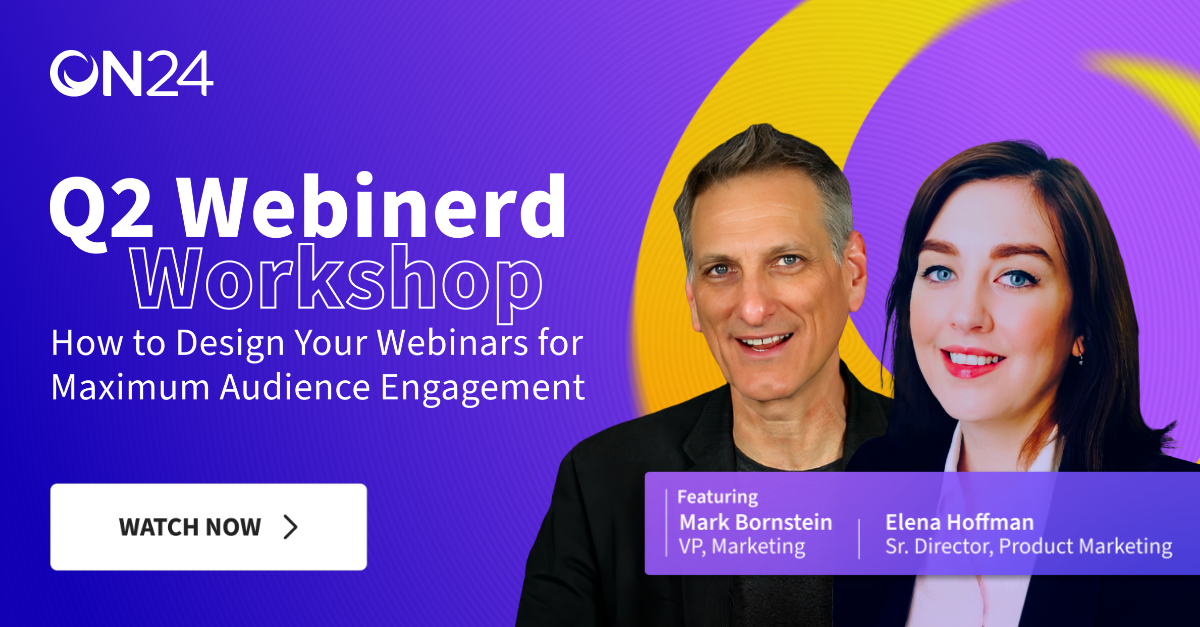Marketers are always told to drive audience engagement to improve pipeline. But what does audience engagement really mean, and how can you succeed at it?
In simple terms, audience engagement is the interaction between viewer and presenter. Anytime you’ve been in an audience and asked to answer questions or participate in a poll by a “show of hands,” — you’ve been part of an engaged audience. Even breaking out into small groups with those sitting next to you is another form of engagement.
But what about digital events? We know that engagement applies to webinars, and that in the past, your audience may have been considered engaged if they just signed up and provided their name and contact info.
Now, webinar hosts and organizers are looking for a different level of digital engagement. They want more than just a number of leads — they want qualified leads that will turn into conversions and loyalty. They want appointments booked with potential future customers.
The right audience engagement can do much more than deliver qualified leads. It can also tell your team what content resonates most with your audience, which can help your team accelerate the buying journey.
Your webinar engagement goals need new standards. Let’s see what you can do to drive audience engagement:
What is audience engagement?
We learned that audience engagement is the interaction between webinar presenter and attendee, but in even simpler terms, it’s audience interest. In the context of a webinar, garnering webinar audience interest comes down to conversion tools. Polls, Q&As, content hubs, live chat features, and demo options help you fold the entire customer journey map into your webinar.
But not all engagement is the same. Let’s take a look at the different types:
Examples of webinar engagement

Active Engagement:
Active engagement can be defined by moments where audience members are actively engaging with webinar presenters and hosts. Features like Chat, Q&A, breakout rooms, and group discussion help facilitate active engagement. This type of engagement happens in real-time and can occur during live webinars.
Passive Engagement:
Passive engagement is defined as moments where webinar audience members are engaging with webinar features, but not actively interacting with the webinar host or hosts. Examples include: polls and surveys, CTA tools (like ‘ book a meeting’), downloadable resources, and social media links. This type of engagement can also happen on live webinars, but it can keep the conversation going after the webinar switches to on-demand.
How to boost audience engagement
Now that you know the different types of audience engagement, how can you increase overall webinar audience interaction?
Use design to your advantage
First: harness your creativity. Develop an engaging webinar console that reflects your brand with your logo. You can customize CTA buttons by adding photos and changing colors, all for a consistent look and feel.
The goal is to create an experience that engages the attendee. Your console can be simple and streamlined or more complex with detailed images. It should reflect your brand and speak to your authenticity.
Have housekeeping upfront
Before your presenter gets into the meat of the webinar, have them highlight your webinar agenda, including the engagement tools audiences can use. State that there will be moments for active engagement/participation. If you point out the different tools, audience members can investigate based on what sounds interesting.
Since most platforms have a tile-like format (picture an app layout on your smartphone), webinar audiences are most likely used to seeing multiple icons. But it’s up to you to point them out and remind them to use those engagement points throughout the presentation. Use distraction to your advantage—providing audiences with different options gives them something to engage with during your virtual event.
Ask for audience opinion
Make sure you ask for audience feedback on whatever subject you are presenting. A 10-15 minute Q&A session at the end can help answer webinar audience questions that viewers are bound to have and share opinions.
Brainstorming sessions are helpful not only for the viewer but also for your team. These sessions can lead to great ideas for future content and allow your viewers to participate actively. A good brainstorming session can also lead viewers to follow up and see if you’ve acted upon some of the ideas that were discussed. Asking for audience opinion continues to engage even after the webinar has ended.
Provide resources, handouts
Make sure attendees walk away from your webinar with something that helps them, whether it’s your latest research or a link to an ROI calculator. Having something in hand, like content to read later, can help keep your brand top-of-mind.
Personalize your webinar experiences
Beyond a custom console, webinars can be personalized to an attendee. Before your event, make sure you set up audience segments to create engagement opportunities depending on where attendees are within your sales funnel.
For example, are you trying to target a decision maker who can become a conversion, or are you delivering information to participants looking to obtain certification? Who you tailor your event to will determine what kind of engagement tools you include.
For example, you can provide one type of CTA resource to one segment and a different CTA to another. Additionally, you can dynamically display an account’s logo in a webinar console, which is useful for an ABM play or a series designed specifically for one account.
Tailor engagement opportunities to your event format

Not all webinars present content in the same way. When designing your webinar for engagement, keep in mind the webinar format you’ll use. For example, if your format is a Q&A panel, consider highlighting chat and Q&A tools to attendees so they can submit questions, spark conversation and help make the event feel more organic and conversational.
It’s those moments of engagement that can further the relationship between the presenter and the audience show viewers that presenters are actually listening.
Make sure your webinar engages with a purpose
Boosting audience engagement just for the sake of boosting audience engagement is a weak strategy. The ultimate goal is to drive leads to conversions and increase your bottom line, but there are several different ways to achieve this. Understand what you want audiences to engage with before your event and measure success against that plan.
For example, you may want them to participate in a breakout room or respond to polls. Consider if you would like them to download specific resources and what you would like them to take away from those resources.
Analyze audience engagement data
Whether you met your primary engagement goals or not, take the time to analyze audience behavior and engagement metrics from your webinar.
Identify where audiences engaged the most. Use those insights to spur more engagement in future events; maybe try using different console tools to see if that yields better results. You can also use these insights to generate additional content like video clips, blogs, or e-books.


